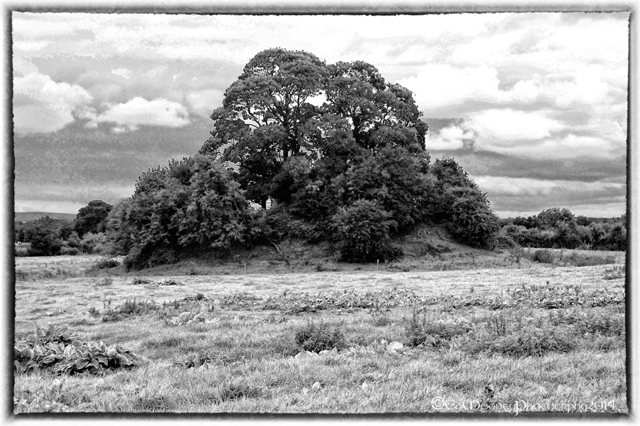The last of the sites on our recent visit to Aghaboe was the Motte and Bailey Situated in between the Standing Stone and Abbey. Aghaboe or Achadh Bhó to give it its proper Gaelic name, means Ox’s Field and derived that name from the fertility of its soil and the quality of its pastures. This tree covered Motte and Bailey was former site of a Norman fortification which can be seen in the field just north of the Abbey. It was granted to Adam De Hereford by Strongbow in 1172AD. A Motte-and-bailey castle is a fortification usually made from wood or stone. The keep/main castle structure would be situated on a raised earthwork called a Motte, accompanied by an enclosed courtyard, or bailey, this would then be surrounded by a protective ditch and palisade. This particular Motte is almost square with a base diameter of approx 42 meters and 36 meters at the top. It is virtually impossible to see any signs of a fortification here as the Motte has been reclaimed by nature. But it has been reported that a grass covered wall once stood at the top of the Motte, surrounded by a shallow fosse. It was quite a normal occurrence for a wooden structure to be constructed first, during the early Norman period. Then if the site survived the hostilities of the day, it would later be upgraded to a stone structure and expanded.
Whilst looking through various sources for any further history on this particular site, I came across two other names that it was also known as. Those being the ‘Ráth of Laragh’ and the ‘Moat of Monacoghlan’. Now Moat is a similar word to Motte with similar meaning. But ‘Ráth‘ was a term used to describe a circular earthen wall forming an enclosure and serving as a fort and residence for a tribal chief. To this day there are many place names all over the country which carry this term, Rathangan in Kildare and Rathcoole in County Dublin both spring to mind, the former still to this day has a massive mound in the town, whilst the later is believed to have been the early childhood home of Fionn Mac Cumhaill, legendary leader of the Fianna. And so the ‘Ráth of Laragh’ got me thinking. Perhaps prior to the Norman arrival in Aghaboe was this great mound the site of an ancient Gaelic chieftains home? It’s hard to find any mention of such a place except for the clue in the name. This is a common issue with researching ancient Ireland as our ancestors had an oral tradition, where stories were never written down, but passed on by word of mouth. The first written records from Ireland did not start until the arrival of Christianity to the Island. When monks would write down some of the ancient stories and presumably added their own twist to them.
For these and more of my images, why not visit my Website or join me on Facebook or Twitter.







Fascinating photos, and I always enjoy your commentary. Just one complaint – I find the white print on black background a little difficult to read – is it just me?
LikeLiked by 1 person
Thank you Maureen, glad you liked them. Interesting point about the text and background. I wonder does anyone else find this an issue. I would be interested in peoples opinion, perhaps it might be something that could be changed ?
LikeLike
…or maybe it’s just my eyes growing old…
LikeLike
Excellent photo Ed.
LikeLiked by 1 person
Thank you, glad you liked it 🙂
LikeLike
wow
LikeLiked by 1 person
Lovely story Ed! I am intrigued now by your question… who, or what, indeed was Laragh?!! You can be pretty sure the site’s history does go further back. Funny, cos I look at those images, and to me, covered with trees like that, its hard to see the actual shape, but it looks much like a mound. Interesting that in such flat terrain it has been ‘let be’ instead of farmed over… I’m wondering if the site has ‘fairy rath’ origins…
LikeLiked by 1 person
I reckon it was definitely something much older. We actually have a bronze age burial mound on the grounds were I work in Dublin, The only one of nine in the area that survived 🙂
LikeLiked by 1 person
Wow that is so cool! Do you know any of the history/ mythology about it?
LikeLiked by 1 person
Nothing major just a few bits n pieces, its an old post.
LikeLike
Another great photo with first rate research!
LikeLiked by 1 person
Wonderful photo. What a long, long history.
LikeLiked by 1 person
Thank you, Shame we cant find out exactly just how long it goes back 🙂
LikeLiked by 1 person
The trees being where the castle was/should be makes for a fascinating beauty that transcends time. (I have no problem with the text and background. They fit with the photographs)
LikeLike
Thanks Simon 🙂
LikeLike